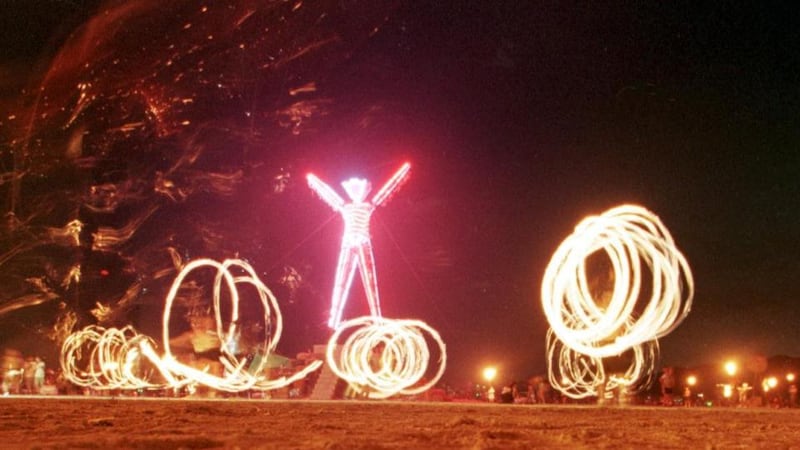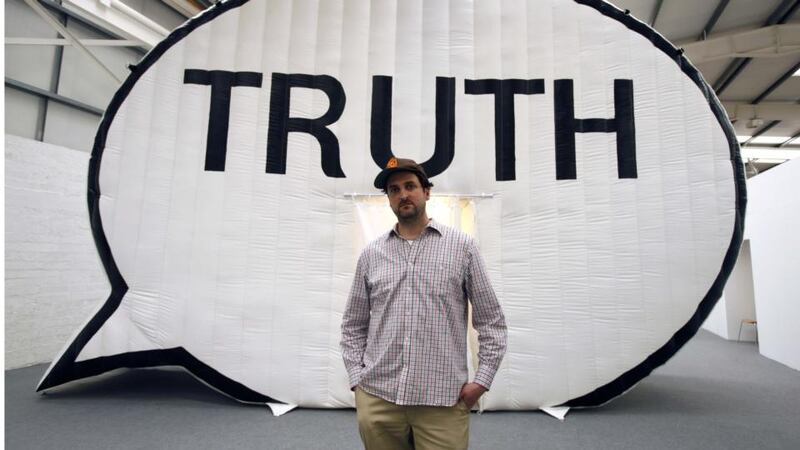Last year 30,266 people went to the former Atlantic Homecare store in Galway to see an art exhibition. Queues formed before the doors opened, and that many people visited in just two weeks. David Mach's Precious Light was the centrepiece for the visual-arts strand of the 2012 Galway Arts Festival. The exhibition, which included huge collages of scenes from the King James Bible and enormous wire figures on crosses, was a stunning event – and similar successes are replicated at festivals around the country each summer.
So if people flock to such exhibitions, why does Galway not have a major space for showing contemporary art (notwithstanding its excellent smaller galleries)? And why are those visitor numbers not replicated all year and all over the country? To put it another way, what is it that arts festivals do differently, and should our arts institutions sit up and take notice?
In 2011 and 2012 I was guest artistic director of Kinsale Arts Festival, an experience that brought home to me the range of what people want and expect from art. It also brought particular challenges, especially as Kinsale has no year-round arts space.


So we improvised and put a video by the French artist Thomas Leon about the end of the world, Living in the Ice Age , in the former magazine room at Charles Fort, opened up the old Mill Building and installed a plastic inflatable theatre, which gave us sleepless nights about its staying power.
These obstacles are part of what makes arts festivals so brilliant. As Paul Fahy, Galway Arts Festival’s artistic director, puts it: “We did pop-up before pop-up became trendy.” It’s one of the things that breaks down the barriers to seeing art, as the art comes out to meet you. Exhibitions take over shops, churches, bars, hotel foyers, historic buildings and abandoned ones.
In 2008 I was haunted by Helena Gorey's In Memoriam at a ruined church at the edge of Kilkenny; that same year I loved Anne Ffrench's Butter Virgins , which was in a freezer cabinet at SuperValu in Kinsale.
In 2010 I was as intrigued as the rest of the capital by Fergal McCarthy's Liffeytown , an installation of Monopoly houses in the Liffey, as part of Dublin Fringe Festival – and agai n in 2011 , when McCarthy was back with the f ringe, this time living on a " desert island" in the river for No Man's Land .
At Éigse Carlow next month they are using the festival opportunity to temporarily open up Dublin Street, a relatively rundown part of the town, offering spaces to artists and others, plus a pop-up by the Science Gallery. It’s not something you could sustain all year round, but festivals can become catalysts with projects such as this. There’s something about the festival atmosphere that gives people permission to go, see and have an opinion. It also gives artists the scope to realise astonishing projects – as did McCarthy.
But, as I know too well from Kinsale, running a festival is an enormous juggling act, not only of programme elements but also, critically, of budgets. If you don’t sell the tickets you’re in deep trouble. So why programme free events such as the visual arts at all?
Paul Fahy agrees that in the past the visual arts were often the poor cousin of theatre, literature and music at festivals, but he points out that it has a vital role in what festivals are all about: transforming things, whether that means disused spaces or people’s ideas and perceptions.
This is what drives Avril Stanley to integrate art into the Body and Soul Festival, which takes place next month in the grounds of Ballinlough Castle, in Co Westmeath, and includes Nick Cave as a headline act on the music stage. “It’s taking art out of its known environment,” she says. “And it’s encouraging people to shape shift themselves a little.”
Stanley, who was partly inspired by the Burning Man festival, which is held in the Nevada desert, says if you get it right the people become part of the art. “You can set something alight in people,” she says. At Body and Soul these creative firelighters have included Aoife Banville’s trees laden with light bulbs, huge paper fish by Janey Groves hovering over ornamental pools, and a maze of string and lampshades by Lace and Wine.
So if art’s known environment is so deadening, what’s the point of having galleries?
Josephine Kelliher and Patrick Murphy are both firmly embedded in the gallery world. Kelliher is director of the Rubicon Gallery, on St Stephen’s Green in Dublin, Murphy of the Royal Hibernian Academy. Kelliher curates the art strand at Kilkenny, and for the past few years Murphy has done the same at Kinsale.
“I don’t regularly curate for festivals,” he says, “but when I do I am conscious that it will been seen by a wide cross section of the public and not a specialist audience. As such I think that the art has to be direct and engaging and not self-reflexive or academic.”
Kelliher agrees, adding that it may be a slightly different vision but that it’s also an opportunity to widen audiences for the visual arts.
One thing to remember, though, is that, a bit like “love”, when people say “art” they may not always be talking about the same thing. There’s the art that sells for astronomical sums at auction; the art that may exist only as an idea (and a difficult idea at that); the art that creates an environment; and the art that people make at home at the weekends because they have an irresistible itch to express something in pencil or paint. All have their own devotees, and all have people who care passionately about them.
An occupational hazard of being a festival director, even temporarily, is being at the receiving end of an onslaught of opinions while, conscious of the role, smiling politely throughout. Once a woman came up to me at a party after Kinsale Arts Festival and said: “I didn’t think much of the art at the festival last year.”
“Gosh,” I said, “not Abigail O’Brien’s marvellous pink inflatable tank?” She hadn’t seen that. “Not the Hogarth etchings?” She hadn’t seen those either. I wondered what she had seen.
“Oh, the art in the shop windows.”
She was referring to the Walking Gallery , Kinsale's annual exhibition of work by local artists, set up around the town. I asked why she hadn't visited the other exhibitions. "They're free," I said, "and they can't make you stay if you're not enjoying them."
“Oh,” she replied. “They wouldn’t be for me.”
You can’t win them all.
This summer there will be more festivals in Ireland than ever, but perhaps the question should be not only what should galleries do differently but also what should we, as audiences, do differently?
The answer is that we should try to hang on, year round, to some of the festival spirit of adventure. That sense of "why not?" If we didn't have the everyday, we couldn't revel in the different. But we can steal little bits from festival time to sustain us throughout the year.
ART AT FESTIVALS: THREE UNFORGETTABLE EXPERIENCES
ANYA GALLACCIO
Charles Fort
, Kinsale Arts Festival 2008
Charles Fort was designed by William Robinson, also architect of the Royal Hospital Kilmainham, home of the Irish Museum of Modern Art. In 2008, nursing a morning-after-the-night-before festival feeling, I discovered that the Scottish artist Anya Gallaccio (left) had filled the empty windows of this historic star fort with sheets of coloured Perspex. It seemed slight to start with, but, as I sat on the grassy banks watching the light change as clouds scudded past the sun, the building came alive with the ghosts of colour. Beautiful.
JACCO OLIVIER
Kilkenny City Courthouse, Kilkenny Arts Festival 2011
Getting the chance to poke around often-closed buildings is part of what makes festivals fun. Kilkenny City Courthouse isn't exactly closed to the public, but it's not a place you'd choose to linger – except in 2011, when the main concourse was darkened and two huge screens showed the work of the Dutch artist Jacco Olivier. Olivier films his paintings as they happen, so Revolution was a constantly evolving cosmos of stars and planets, sweeping across a night sky. Opposite Landscape gave a more earthly view, but I, like most people gathered to watch, chose heaven every time.
FERGAL McCARTHY
No Man's Land, Dublin Fringe Festival 2011
Dubliners and visitors during the 2011 fringe festival were surprised to see a desert island appear in the middle of the River Liffey, where it runs past the IFSC at the Samuel Beckett Bridge. McCarthy (above) spent the fringe living in an orange tent pitched on the golden sands, wearing a banker's suit and taking the shade under a pair of palm trees. Commenting on escapism, reality, dreams and the consequences of choice, No Man's Land made people see economic collapse, the Liffey and Dublin's north-south divide in an entirely different way.
MAKE YOUR PLANS: SUMMER FESTIVAL ART HIGHLIGHTS
CARLOW
June 7th-16th,
eigse.com
Beasts of England, Beasts of Ireland: fantastic animals by contemporary artists. Curated by Stephen Brandes.
BODY AND SOUL
June 21st-23rd,
Co Westmeath, bodyandsoul.ie
Installations and environments by Ulf Mark Pederson, Felix Power and Aoife Banville.
KINSALE
July 6th-14th
, Co Cork, kinsaleartsfestival.com
Once Upon a Time, folklore and fantasy, including Peter Burns, Marie Connole, Mark McGreevy and Mary Noonan, curated by Patrick Murphy.
GALWAY
July 15th-28th,
galwayartsfestival.com
The hugely successful Irish 3D video artist John Gerrard alongside the British painter Howard Hodgkin.
BIG HOUSE
August 3rd-5th,
Castletown House, Co Kildare, bighouse.ie
Includes work by Oisin Byrne and Áine Phillips. See also the excellent Contemporary Castletown, curated by Dawn Williams, until June 30th.
KILKENNY
August 9th-18th,
kilkennyarts.ie
The brilliant Bob and Roberta Smith, aka the British artist Patrick Brill, brings his unique vision to the streets and spaces of Kilkenny. Curated by Josephine Kelliher.













